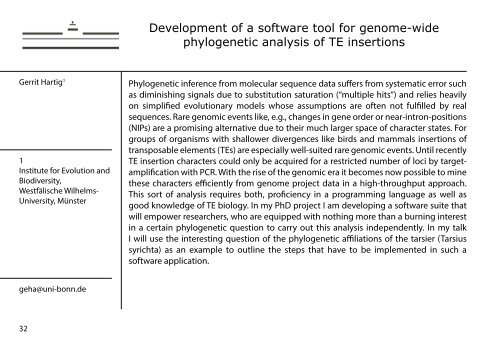2nd annual MGSE Symposium - Institute for Evolution and ...
2nd annual MGSE Symposium - Institute for Evolution and ...
2nd annual MGSE Symposium - Institute for Evolution and ...
You also want an ePaper? Increase the reach of your titles
YUMPU automatically turns print PDFs into web optimized ePapers that Google loves.
Gerrit Hartig 1<br />
1<br />
<strong>Institute</strong> <strong>for</strong> <strong>Evolution</strong> <strong>and</strong><br />
Biodiversity,<br />
Westfälische Wilhelms-<br />
University, Münster<br />
geha@uni-bonn.de<br />
32<br />
Development of a software tool <strong>for</strong> genome-wide<br />
phylogenetic analysis of TE insertions<br />
Phylogenetic inference from molecular sequence data suffers from systematic error such<br />
as diminishing signals due to substitution saturation (“multiple hits”) <strong>and</strong> relies heavily<br />
on simplified evolutionary models whose assumptions are often not fulfilled by real<br />
sequences. Rare genomic events like, e.g., changes in gene order or near-intron-positions<br />
(NIPs) are a promising alternative due to their much larger space of character states. For<br />
groups of organisms with shallower divergences like birds <strong>and</strong> mammals insertions of<br />
transposable elements (TEs) are especially well-suited rare genomic events. Until recently<br />
TE insertion characters could only be acquired <strong>for</strong> a restricted number of loci by targetamplification<br />
with PCR. With the rise of the genomic era it becomes now possible to mine<br />
these characters efficiently from genome project data in a high-throughput approach.<br />
This sort of analysis requires both, proficiency in a programming language as well as<br />
good knowledge of TE biology. In my PhD project I am developing a software suite that<br />
will empower researchers, who are equipped with nothing more than a burning interest<br />
in a certain phylogenetic question to carry out this analysis independently. In my talk<br />
I will use the interesting question of the phylogenetic affiliations of the tarsier (Tarsius<br />
syrichta) as an example to outline the steps that have to be implemented in such a<br />
software application.



